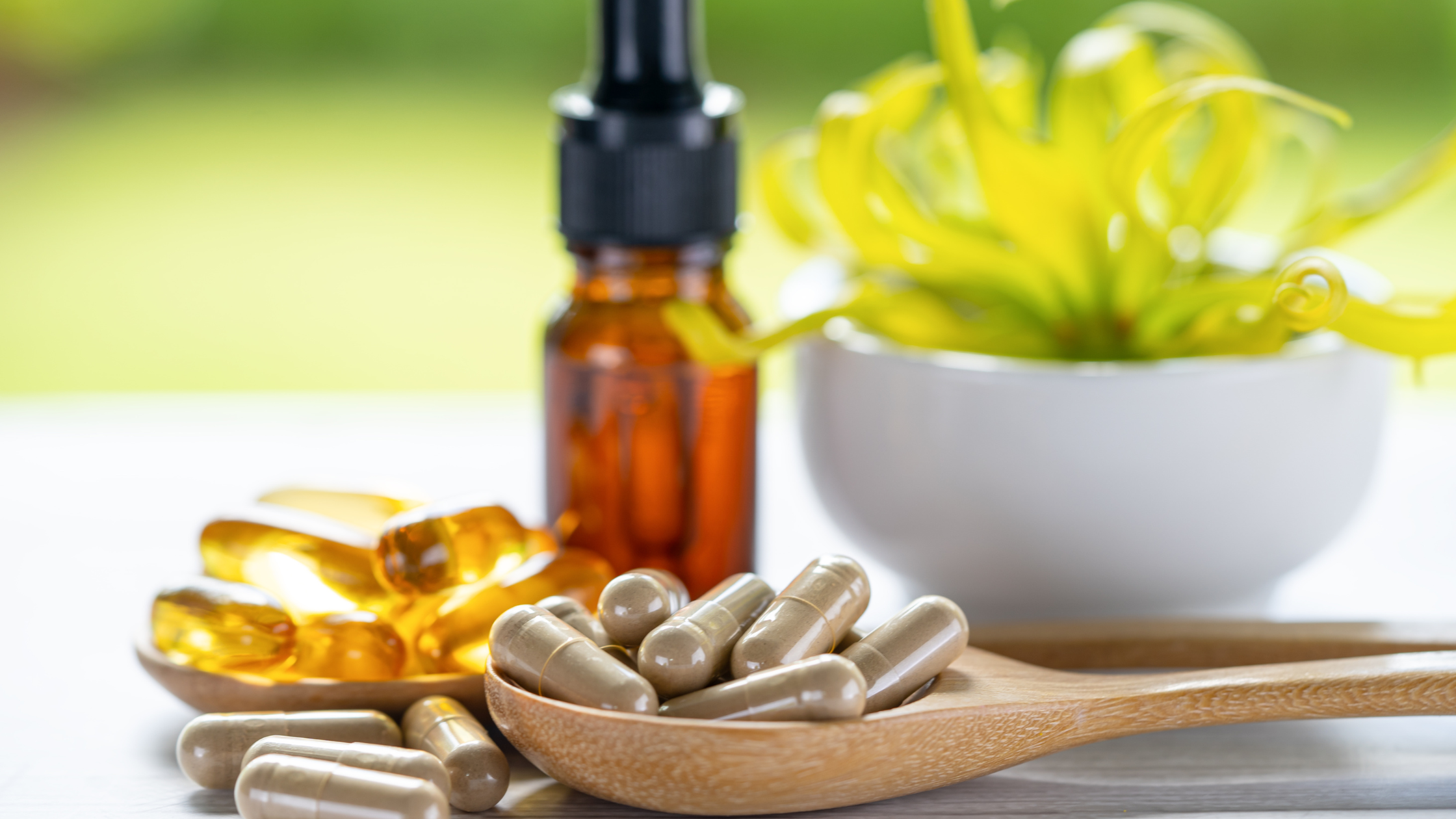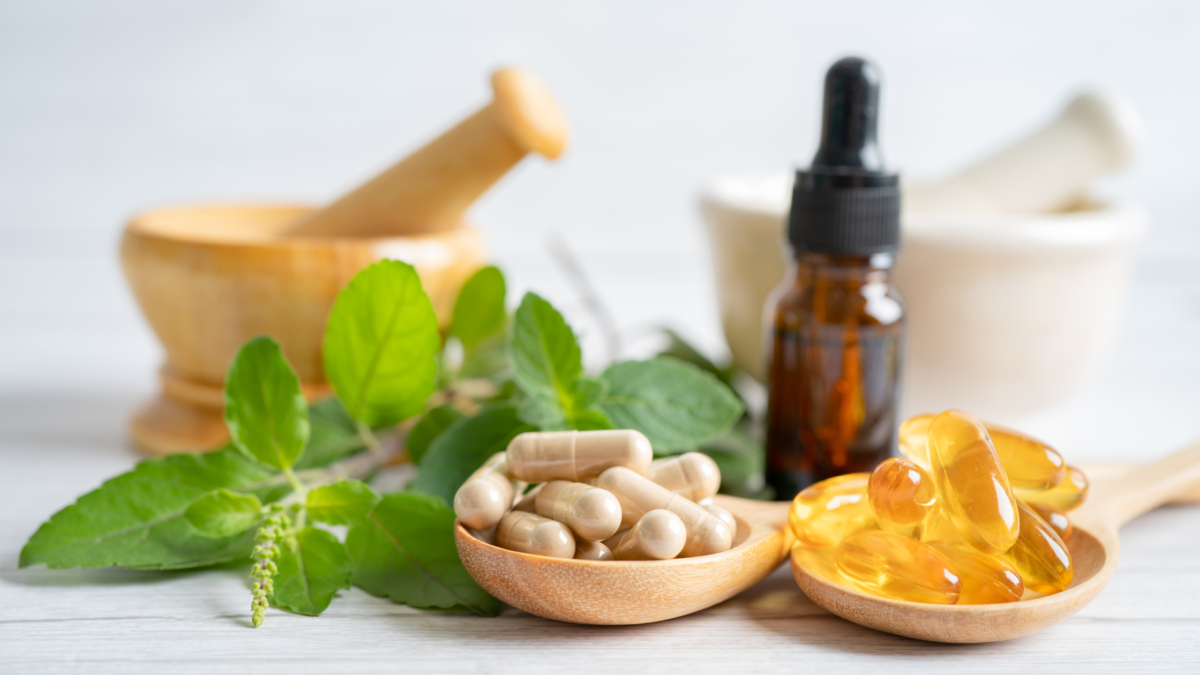


Medically Reviewed By Margaret Etudo. Written By The Vitamins For Woman Team.
Are you looking for relief from hot flashes and mood swings? Discover the best herbal remedies for menopause symptoms—natural options that work without hormone replacement therapy (HRT).

Menopause is a natural life transition, but that doesn’t mean it comes without challenges. Hot flashes, night sweats, mood swings, joint pain, fatigue, and hormonal imbalances can significantly impact your quality of life.
While hormone replacement therapy (HRT) can be effective, many women aged 45–60 are actively looking for safer, more natural alternatives. Herbal remedies are becoming a popular choice for managing menopause symptoms—and it’s easy to see why.
Some herbs have natural plant-based compounds called phytoestrogens that can help gently balance your hormones. Others have calming or anti-inflammatory effects that support your overall well-being. When used safely and correctly, these herbs can offer real relief without the potential side effects of synthetic hormone treatments.
This article will explore why herbs help with menopause, outline safety considerations, and review the top 10 herbs for symptom relief. You’ll also find tips for herbal supplements and answers to women’s common questions when considering natural solutions.
During menopause, estrogen levels decline, triggering many of the hallmark symptoms. Synthetic HRT replaces this lost estrogen but is not suitable for everyone—especially women with a history of hormone-sensitive cancers, blood clots, or cardiovascular disease.
Some herbs, like red clover and soy, contain phytoestrogens, plant-based compounds that weakly bind to estrogen receptors. While not as potent as synthetic estrogen, they may offer menopause symptom relief without HRT, particularly for hot flashes, bone density, and mood.
Others, like ashwagandha and maca, don’t directly affect estrogen levels but support the body’s stress response and adrenal function—essential systems for maintaining hormonal balance in midlife.
Natural doesn’t always mean safe. Herbs can interact with medications, affect liver enzymes, or cause side effects like digestive upset or headaches. For example, black cohosh has been linked to rare liver problems, and dong quai may increase bleeding risk.
If you’re on blood thinners, antidepressants, or managing conditions like high blood pressure, diabetes, or breast cancer, speak with a healthcare provider before starting any herbal supplement.
One of the most studied herbal remedies for menopause symptoms, black cohosh is often used for hot flashes, night sweats, and mood swings. It doesn’t contain phytoestrogens but may work through serotonin pathways and other temperature regulation mechanisms.
Evidence: A 2021 review concluded that black cohosh may be effective for vasomotor symptoms, although it had mixed results. It’s often combined with other herbs for a more comprehensive effect.
Use: Standardized extract (20–40 mg/day); avoid long-term use beyond 6 months unless supervised.
Caution: Avoid if you have liver issues or a history of hormone-sensitive conditions.
Red clover contains isoflavones, a type of phytoestrogen that mimics estrogen’s effects on bones and blood vessels. It is commonly used in teas or capsules.
Evidence: Some small trials suggest red clover may help reduce hot flashes and support bone density, although more research is needed. It is often recommended for women who cannot take HRT but want estrogen-like support.
Use: 40–80 mg isoflavones/day; look for standardized extracts.
Caution: It may interact with blood thinners; consult your doctor if you have a bleeding disorder.
In Traditional Chinese Medicine, dong quai (Angelica sinensis) is often called “female ginseng.” It’s believed to improve circulation and balance estrogen levels.
Evidence: Studies are limited, but dong quai may help with fatigue, mood swings, and menstrual-like cramping during perimenopause.
Use: Often taken as part of a formula; typical dose ranges from 500–1500 mg/day.
Caution: Avoid if you are on blood thinners or have a history of hormone-sensitive cancers.
Maca, a root native to Peru, has long been used to help boost energy, lift mood, and support libido. While it doesn’t contain phytoestrogens like other herbs, it may work by gently supporting the brain’s hormone-regulating centers, helping your body find better balance over time.
Evidence: A review found that maca improved sexual function and reduced symptoms like anxiety and depression in postmenopausal women.
Use 1.5–3 grams per day of gelatinized maca powder.
Caution: Generally well-tolerated but may cause jitteriness in sensitive individuals.
Also known as Vitex agnus-castus, chasteberry is more commonly used for PMS, but it can support hormonal balance in early perimenopause when progesterone starts to decline.
Evidence: It may help with mood swings and breast tenderness by influencing dopamine and prolactin levels.
Use: 20–40 mg standardized extract daily.
Caution: Avoid if on dopamine-related medications or birth control.
Sage (Salvia officinalis) has anticholinergic properties that may reduce excessive sweating and hot flashes.
Evidence: A 2011 study showed reduced hot flashes by up to 64% after 8 weeks of sage extract.
Use: Capsule, tincture, or tea; look for clinically studied brands (e.g., Menosan).
Caution: Avoid high doses if you have epilepsy or high blood pressure.
Ashwagandha is a natural herb used in Ayurvedic medicine that helps your body handle stress. It supports your adrenal system and helps keep cortisol—your primary stress hormone—healthy. Healthy cortisol can make it easier to manage anxiety, sleep better, and keep hormones more balanced when stressed.
Evidence: Clinical studies show it improves sleep quality and reduces stress in adults, including those in midlife.
Use: 300–600 mg of standardized extract (withanolides 5%).
Caution: It may lower blood pressure or blood sugar; check interactions.
Rhodiola rosea is another adaptogen that is helpful for mental fatigue, especially in women juggling menopause and work-life responsibilities.
Evidence: Shown to improve focus, memory, and stamina. Helpful for midlife burnout.
Use: 100–400 mg/day of standardized extract.
Caution: It may cause overstimulation; avoid combining with caffeine.
Rich in gamma-linolenic acid (GLA), evening primrose oil supports hormonal balance and may help with joint pain, skin health, and tender breasts.
Evidence: Mixed, but some women report symptom relief, particularly when combined with omega-3s.
Use: 500–1000 mg/day.
Caution: May interact with anticoagulants or lower seizure threshold in at-risk individuals.
Licorice root contains compounds that may act similarly to estrogen and can help with fatigue, mood, and hot flashes.
Evidence: Short-term use has shown improvements in vasomotor symptoms.
Use: DGL (deglycyrrhizinated licorice) is safer for long-term use: 200–300 mg/day.
Caution: Not recommended for those with high blood pressure or kidney disease.
Consistency is key—many herbs take 4–8 weeks to show results.
Avoid herbal remedies if you:
Always consult a qualified healthcare provider or pharmacist before combining herbs with medications.
Black cohosh and sage are among the best herbs for natural remedies for hot flashes. Red clover may also help due to its phytoestrogen content.
Most women begin to see benefits within 4–8 weeks of consistent use. Some herbs, like adaptogens (ashwagandha, maca), may work faster for energy and mood.
Possibly—but many herbs interact with blood pressure drugs, antidepressants, blood thinners, or hormone therapies. Always ask your pharmacist before starting a new supplement.
Herbal remedies for menopause symptoms can offer meaningful relief—especially for women who prefer to avoid synthetic HRT.
Whether you’re dealing with hot flashes, mood swings, joint aches, or low energy, the right mix of herbs can help support your body gently and naturally during this stage of life.
Start with one or two herbs based on your most bothersome symptoms, monitor your progress, and always prioritize safety. You don’t have to navigate menopause alone—and you don’t have to choose between suffering or synthetic hormones.
Kargozar R, Azizi H, Salari R. A review of effective herbal medicines in controlling menopausal symptoms. Electronic Physician. 2017;9(11):5826.
Zhang F, Yang D. A meta‐analysis: anti‐inflammatory medicinal plants for age‐related menopause‐like symptoms and psychological problems in breast cancer and healthy perimenopausal women. BJOG. Published online May 7, 2025:1471-0528.18209.
Harper-Harrison G, Carlson K, Shanahan MM. Hormone replacement therapy. In: StatPearls. StatPearls Publishing; 2025.
Mesiano S, Katz SL, Lee JY, Jaffe RB. Phytoestrogens alter adrenocortical function: genistein and daidzein suppress glucocorticoid and stimulate androgen production by cultured adrenal cortical cells. J Clin Endocrinol Metab. 1999;84(7):2443-2448.
Nunes DR da CMA, Monteiro CS de J, Santos JL dos. Herb-induced liver injury—a challenging diagnosis. Healthcare. 2022;10(2):278.
Powell SL, Gödecke T, Nikolic D, et al. In vitro serotonergic activity of black cohosh and identification of nω-methylserotonin as a potential active constituent. Journal of agricultural and food chemistry. 2008;56(24):11718.
Castelo-Branco C, Gambacciani M, Cano A, et al. Review & meta-analysis: isopropanolic black cohosh extract iCR for menopausal symptoms – an update on the evidence. Climacteric. 2021;24(2):109-119.
Thorup AC, Lambert MN, Kahr HS, Bjerre M, Jeppesen PB. Intake of novel red clover supplementation for 12 weeks improves bone status in healthy menopausal women. Evidence-based Complementary and Alternative Medicine : eCAM. 2015;2015:689138.
NCCIH: Red clover; usefulness and safety. NCCIH.
WebMD: Dong quai: overview, uses, side effects, precautions, interactions, dosing and reviews.
Minich DM, Ross K, Frame J, Fahoum M, Warner W, Meissner HO. Not all maca is created equal: a review of colors, nutrition, phytochemicals, and clinical uses. Nutrients. 2024;16(4):530.
Brooks NA, Wilcox G, Walker KZ, Ashton JF, Cox MB, Stojanovska L. Beneficial effects of Lepidium meyenii (Maca) on psychological symptoms and measures of sexual dysfunction in postmenopausal women are not related to estrogen or androgen content. Menopause. 2008;15(6):1157-1162.
Puglia LT, Lowry J, Tamagno G. Vitex agnus castus effects on hyperprolactinaemia. Frontiers in Endocrinology. 2023;14:1269781.
Hamidpour M, Hamidpour R, Hamidpour S, Shahlari M. Chemistry, pharmacology, and medicinal property of sage (Salvia) to prevent and cure illnesses such as obesity, diabetes, depression, dementia, lupus, autism, heart disease, and cancer. Journal of Traditional and Complementary Medicine. 2014;4(2):82-88.
Bommer S, Klein P, Suter A. First time proof of sage’s tolerability and efficacy in menopausal women with hot flushes. Adv Ther. 2011;28(6):490-500.
Ashwagandha. In: LiverTox: Clinical and Research Information on Drug-Induced Liver Injury. National Institute of Diabetes and Digestive and Kidney Diseases; 2012.
Stojcheva EI, Quintela JC. The effectiveness of rhodiola rosea l. Preparations in alleviating various aspects of life-stress symptoms and stress-induced conditions—encouraging clinical evidence. Molecules. 2022;27(12):3902.
Evening primrose oil: overview, uses, side effects, precautions, interactions, dosing and reviews. WebMD
Boonmuen N, Gong P, Ali Z, et al. Licorice root components in dietary supplements are selective estrogen receptor modulators with a spectrum of estrogenic and anti-estrogenic activities. Steroids. 2015;105:42.

medically reviewed by margaret etudo, BPharm. written by the vitamins for woman team.